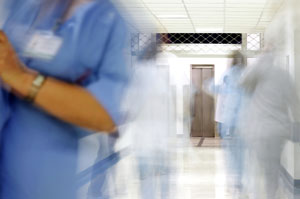There are patients in almost every hospital emergency room who do not need urgent care. They are there because they don’t have health insurance or a regular physician, or they didn’t know what else to do. Often, they are repeat visitors. It’s a problem that leads to emergency department overuse and contributes to spiraling health care costs.
Nationally, between 13.7 percent and 27.1 percent of all emergency department visits are non-urgent, according to a 2010 Health Affairs study, leading to about $4.4 billion in health care costs.
 North Carolina’s Pardee Memorial Hospital, located in Hendersonville, has joined forces with local physicians in an attempt to reverse this cycle – and program data suggest the plan is working.
North Carolina’s Pardee Memorial Hospital, located in Hendersonville, has joined forces with local physicians in an attempt to reverse this cycle – and program data suggest the plan is working.
In 2009, Pardee’s emergency department treated approximately 45,000 patients. Among them the hospital identified 255 as “frequent flyers” – meaning they used the emergency room six or more times and racked up more than $3 million in unpaid medical bills. They were all uninsured, low-income patients, many with a history of substance abuse or mental health issues.
The next year, 44 of these patients agreed to participate in Bridges to Health – an integrated approach that Dr. Steve Crane, a family physician who started the program, calls a “patient-centered medical home on steroids.” It aims to decrease ER expenses by providing this patient population with primary care, behavioral health services and a nurse case manager through bi-weekly health clinic visits.
The program’s free clinic is part medical check-up, part group therapy. While the doctors treat rashes, abdominal pains and other symptoms, the patients also help one another, suggesting where to seek legal assistance or where to eat or sleep inexpensively. As such, the program sets out to address the two main problems seen in these patients: the lack of social support and access to regular primary care.
Advocates of this type of approach believe targeting ER over-users, who generally have limited experience with the health system, will buttress the Affordable Care Act’s provisions designed to expand insurance coverage and access to care.
A 2011 Centers for Disease Control and Prevention survey reported that 46.3 percent of respondent ER patients were in the ER because they had nowhere else to go. The report also found that uninsured adults were more likely than insured adults to go to the ER for this reason.
“Many of these people just went to the ER because they were in pain or scared,” Crane said. “You see them going back so many times because their real issues are not supposed to be treated in the ER and are not taken care of.”
A Targeted Approach
Unlike most free health clinics, where a wide variety of people are seen individually and most people rarely come more than once, Bridges to Health works exclusively with this specific group of ER over-users and each visit is conducted as one large group appointment.
Crane’s program offers these patients a better alternative with long-reaching benefits.
Before enrolling in the program, participants were averaging seven ER visits a year, costing an average of $14,004 per person. At the end of the first year, participants averaged three visits a year, costing an average of $2,760 per person. This amounted to $404,784 in savings for the Pardee Hospital ER that year.
Additionally, 10 participants found employment and six previously homeless members found stable housing by the end of the first year.
Data for the second year is still being analyzed.
While the results of the program are very promising, Crane cautions that the patient group is small, and that the program only works for participants who come to the clinic meetings.
He and his team, however, are hopeful that programs like Bridges to Health will gain more support because they offer a way to hold down health costs, while improving care. A Bridges to Health pilot is on track to be replicated in Charlotte sometime this year, with a few other North Carolina and Virginia counties hoping to also get on board.






